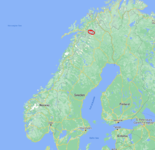Chape1rm
WKR
- Joined
- Apr 15, 2022
Seems like your trip to heaven went to hell in a hurry. Being thirsty sucks, when I read your story I felt your pain. Sounds like the kind of thirsty where your tongue sticks to the roof of your mouth and breathing feels like your sucking on sand paper.Always carry water filtration pills as a back up even if you prefer a Steripen, pump, or squeeze filter as your first choice.
Two springs ago, I left work on Friday around 2 and drove 3 hours to the mountains and national forest to do some solitary trout fishing in a wilderness area.
It was a BEAUTIFUL day. Mid April, trees were starting to bud. So, no humidity. The sun was hot and dry. It was a nice hot though. Sweat didn’t lay on you and the sun just soothed your bones. I was so excited.
I finally got to the gated road and loaded up my pack for the 4 Mile walk in. It was heavy. I brought the kitchen sink in amenities. Potatoes, eggs, precooked brats and breakfast sausage, cooking oil, seasoning, etc…. I brought real food for every meal. With the idea I’d eat a few trout with my pre cooked brats for both suppers.
I didn’t stop there though. I had two bottles of fuel for a single mantle lantern. Etc…. I mean I brought everything. I even brought a fold out chair. I was fixin’ on living it up. It never occurred to me that deciding to not pack the aqua tabs was going to come back and burn me because my Sawyer worked just fine the night I tested before leaving.
On the way in, I walked by two mountain creeks I drink out of a lot. But, I decided I’d wait until I got to camp before fooling with water. Even though I was already very thirsty. Here’s the irony in all this. Even though I brought a filter, I rarely had to ever use it while doing this trip.
It’s important to understand the destination stream always has beaver activity in the head waters. But, there had always been mountain tributaries in the past that I could get water from without worry of filtering. Rendering the filter a security measure more than a dependency. So, I never gave the negligence of getting water on the way in any thought at all.
It was a dry winter too. And a drier spring. So, after walking by the last tributary that was clean, I covered the next 3.5 miles, with a 75 pound pack, in haste to get camp setup, get water, etc… before dark.
When I reached the big stream I intended to fish, I was alarmed by the lack of flow. But, I headed on another 1.5 miles to my camping location. I setup camp and went to the river to filter a 6 liter bag of water and my nalgene full. Because the tributary I had planned to camp by was totally dry. So, still no worries as I still had water. I just had to filter it.
I was so happy to be there. I had supper and a few sips of the pint of Wild Turkey on my mind as I began to try and filter water. Well, you could imagine my irritation when I couldn’t get water to squeeze through the Sawyer. I couldn’t get the Sawyer to twist open either.
How did this happen? I had tried the filter the night before I left to ensure it was working Yet, no matter how hard I tried, I couldn’t water to squeeze through it and, I couldn’t get it twisted open.
So, here it is. I’m 4 miles in with 75 pounds of gear, 3.5 miles from the closest water I can drink unfiltered, and I hadn’t drank anything in about 6 hours, I was dehydrated badly, and out of options.
So I packed everything back up in my pack, and hiked out in the dark back to my truck. When I got within a 1/2 mike of the truck and the first safe water I could drink, I dumped my pack, and slammed a liter of cold spring mountain water like a hammer. Which turned my guts into a wrenching mess. I didn’t care. I filled my nalgene and slowly drank another liter this time.
I filled it the third time while contemplating if I was just going to go home or stay in the bed of my truck and day trip it the next day. Well, my irritation convinced me to just go home and regroup. So, that’s what I did. Got home around 1:30 AM.
A little content to the story too. I had spent all day putting shingles on before leaving at 2. I drove straight there, loaded up everything in my pack, and hiked 8 mikes with a 75-80 pound pack with an already dehydrated body. While not life threatening, I was exhausted. And, I still get po’ed EVERYTIME I see. Sawyer squeeze filter.
I'm loving my stripen ultra but I do take a whirlpak liter bag and Katadyn MP1 tabs in a tin with some waterproof matches, tinder, space blanket and a button compass. I need some peace of mind because if it wasn't for hard luck I wouldn't have any.

